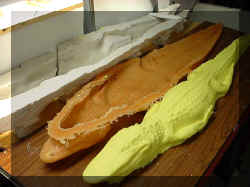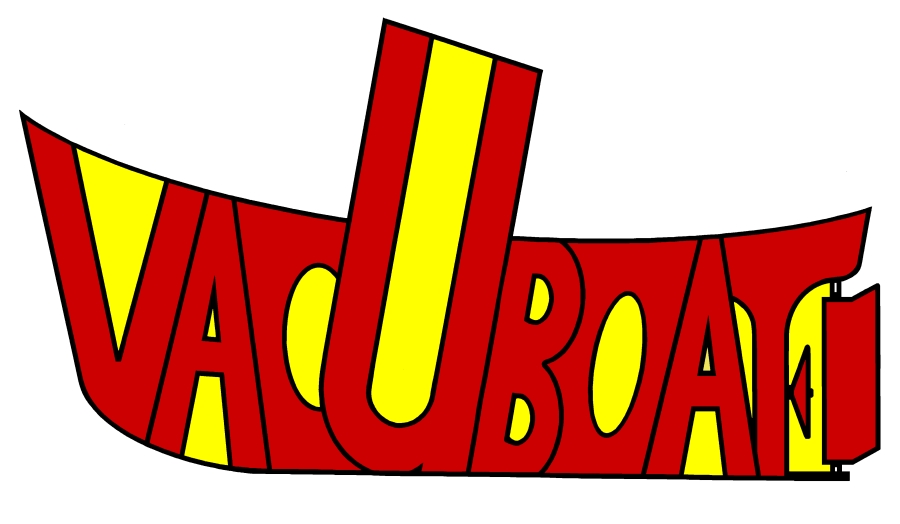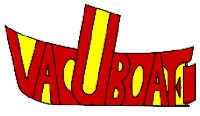Vac-U-GatorTM

|
Radio Controlled Alligator Kit |
UPDATE: November 2013 - If you found this hidden page, I wanted to let you know that I have resumed work on the model. So far so good. It should be completed in 2014. The plan is to move the propulsion unit to the central body and have the remainder reduced to what normally is seen above the water line to reduce resistance. I've solved the tail design and it will be a segmented assembly that should have a nice serpentine action as it moves.
The development of the Vac-U-Gator is on hold at the moment. The first trials went poorly. We are re-thinking the drive system for improvements in power and maneuverability. Development will continue into Winter 2007. Stay tuned!
The world's first vacuum-formed radio controlled alligator.
(The alligators pictured here are not real. They are skillfully hand-made fiberglass replicas.)
Note: Vac-U-Boat is not responsible if your Vac-U-Gator is so realistic that someone calls the local authorities and they haul you and your gator to jail.
Still under development at this time. (Alligator is under construction.) This will be a very slow process. I will post photos when I've made any progress!
(All framed photos will enlarge if you click them.)
The original fiberglass model arrived this week. Not bad looking. A little crooked. Now the real work can begin.
Now I have a rubber copy stuffed with foam pellets. With this, I can straighten out the tail and head, do some cosmetic "surgery" and then use this to make a mold for the vac-u-form plug.
The work is going slower than Christmas! This is a "first-generation" test-form of the five top sections of the gator. Now, I am working on the ball-socket pivot joints for each section. Then, on to the bottom sections that will complete the "hull".
Running into snags on the engineering side of things. Still can be done. Just slowing down a bit to let my brain catch up with the issues.
Decided that the "boat part" will be in the head of the gator. Sounds obvious now, but there is lots more room in the body. It was just too complicated to engineer the head movement to follow the rudder if the boat was contained in the 2nd section of the gator.
Since the head will house all of the radio gear, motor & battery, it will need to be waterproof. Of course, the Vac-U-Gator HAS to have a movable jaw. Still, how to open the jaw and leave a waterproof boat under it? I removed the upper jaw leaving a hollowed-out lower jaw. I filled the area to form a palate. This will form the upper deck of the boat. But, where are the teeth?
Had to make some. Implanted the teeth into the jaw with steel pins so they won't break off during the vacuum forming process.
My dentist would like this part.
While the lower jaw is solid, the upper is just a shell. These teeth are painted on with a thick material as they require only a profile to be trimmed around once the plastic is formed.
A test-mold of the lower jaw is a little odd looking without a top. The slight webbing between the teeth is unavoidable and will be easily hidden with proper painting.
I put a test-mold of the finished upper jaw on it and it looked pretty good!
And, it OPENS! Will be able to open about twice as high as this, depending on the servo you use. I plan to use a short cable or lift-arm to lift the jaw. Still working on that issue.
The "upper gator" is 95% done. This is a 3rd generation test-mold. Only very minor joint/hinge adjustments remain. The final 5% will wait for the flotation liner to be completed as the hinge points will pass through two layers of plastic at each joint.
Under the lower jaw will be a boat-shaped hull with just enough ballast to keep the head properly aligned with the floating body.
The first Swim-Test! Well, it didn't go so well. Not enough power. Not enough torque with the head to cause the body to bend and turn with it. Much like a model submarine I am told. Too slow, Won't turn, etc... Body seems a little high in the water. I plan to increase power. Lower the center-body and raise the tail a bit. Will try again soon. Stay tuned!
-------------------------------------------------------------------
(Future features for the Vac-U-Gator kit.)
The Five and one-half foot Vac-U-Gator kit comes complete with a 545-type 5-pole motor, a single-screw drive system, and easy to install controls for somewhat realistic action. You install your own 2-channel radio, electronic speed control, ballast, and battery. An optional mouth kit may allow you to have him open and close his mouth with a 3rd channel.
It is easy for the novice to build the Vac-U-Gator in just a few hours. Paint it with realistic colors or get creative! The drive system is very durable and should provide years of service with very little maintenance. The H.I.P.S. "High Impact Poly Styrene" hull is lightweight and strong. At full throttle, it runs at a slow lazy pace making it easily controlled by young children without the risk to the "adult toy boats" in the area.
This is an ideal "first kit" for anyone new to alligators. At club meetings it makes a great icebreaker for curious visitors. The basic kit includes the alligator in swimming posture, feet swept rearward. The body and tail are sectioned so it can sway back and forth in a relatively realistic manner.
There is plenty of room inside for your radio gear and batteries. The motor is pre-installed in the motor tray. It draws only .95 Amp cruising at full throttle. With a two channel radio, electronic speed control & regular servo use, the total draw can average 1.3 Amps. With a new, fully charged 2,000mA 7.2 volt Ni-Cad battery, Vac-U-Gator will run for 1.5 to 2.0 hours! Oilite® bearings support the stainless steel prop shaft in a custom drawn brass stern tube. A tube of non-toxic, plastic-friendly Synco Superlube® synthetic grease is included for filling the stern tube. Our exclusive brass motor-prop shaft coupling uses an acetal plastic dogbone that has self-lubricating properties to minimize wear. The resin rudder is cast over a solid brass shaft and supported at the rudder arm with an Oilite® bearing. Screws are stainless steel. A DU-BRO™ E/Z Connector is provided to attach the stainless steel pushrod to the servo and rudder. The Vac-U-Gator can be painted with standard "hobby enamel" short spray cans, or Krylon® Fusion® paint, available at discount & hobby stores.













 TM
TM TM
TM